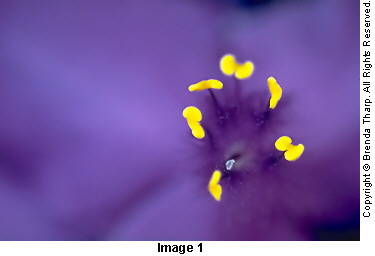
A wide open aperture gave this image the soft background. Photographed with a wide open aperture, 100mm and diopter lens.
As each season prepares to express itself in countless ways, we need to start our own creative juices flowing.
Each year, I vow to do a better job of expressing what I see – what I find in nature. Webster’s dictionary defines “to express oneself” as “to give an expression to one’s feelings, imagination, etc., esp. in creative or artistic activity.” The word “expressive” means “to give full meaning to.” We can use imagination and feelings to help us say more about our subject. The question, then, is how can you create more expressive images?
First, ask yourself what it is you want to express through your image(s). How do you feel about your subject? For example, you’re sitting in a meadow of spring wildflowers; what are your feelings? Are you joyful about the colorful mix of blossoms? Do you feel the abundance, the profusion of a meadow bursting with blooms? Are you delighted with the surprise of a colorful blossom seen through the grasses and other blooms in front of it? The answers to these questions will give you ideas about how to photograph that meadow. They will help you choose the right focal length on your lens, the right aperture and shutter speed combination, and the position and perspective for your composition. After a little self-examination, the end results of your work are more likely to be expressive images, rather than straight, technically perfect ones.
Here are some ideas to kick-start your own expressive photography:
1. Take a Zen approach.
I find that sitting in one place for some time allows me to open up to my creativity, and I begin experimenting. If I’m too busy rushing around, I lose the opportunity to experience and see more deeply that which I’m photographing. Zen teaches us to become the thing we’re observing, to realize the oneness of being. If you can move even part way to that kind of awareness, you’ll be seeing more deeply than ever before, and your photographs will change.
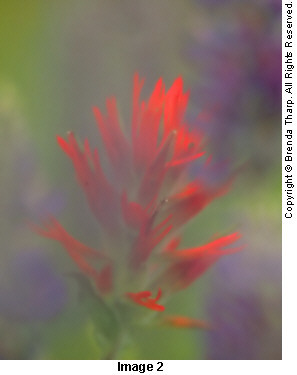
Indian Paintbrush photographed through Wild Iris blossoms. 300mm lens
2. Photograph with wide open apertures.
Photographing ‘wide open’ goes against the grain for many nature photographers. We’re used to minimum apertures to render the scene as sharply as possible. This technique makes good sense for landscape images when we want sharp details. In close-up photography, though, a wider aperture softens the background details and can help to isolate the subject. Why stop there? Why not try also letting your subject be out of focus in certain areas and select a totally wide open aperture for the lens you’re using? Select a certain area of the subject and let that be the focus. For example, to capture the image of a purple spiderwort, (Image #1 above) I didn’t care if the rest of the scene was out of focus. What had to be sharp were the anthers sitting on top of the stamen. The result is a wash of lavender hues as a background, making the impact of yellow really strong.
Another approach is to photograph through other blossoms, grasses, etc., to create an impressionistic effect. The more out of focus something is in the foreground, (see Image #2) the more transparent it is, allowing you to “shoot through” it to something else in focus.
This technique isn’t as easy as it sounds, however. It may take some getting comfortable with the view, and what you see in the viewfinder will be what you make in-camera, so move around your subject until things “fall into place” creatively.
3. Go for the extreme close-up.
Take your macro photography to the limit. Add extension tubes and/or close-up lenses, and delve into the deepest part of your subject. This technique works very well on flowers and foliage. (It won’t do much for the side of a tree trunk.) Immerse yourself in a minute world of abstract design, color, and light. The late Mary Ellen Schulz was an expert on this technique. Others have followed with their own styles of beautiful, impressionistic photography.
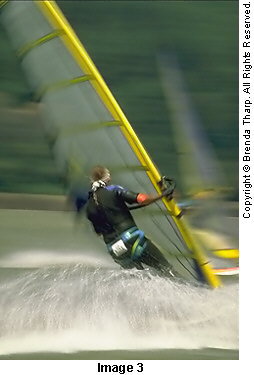
Panned and slow shutter speed technique created a heightened sense of the motion in this windsurfer.
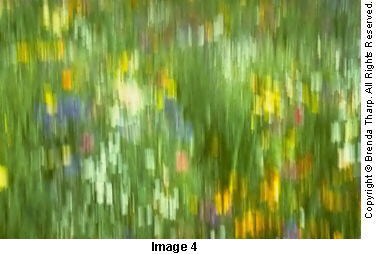
A 1/2 second panned exposure created this abstract of a field of wildflowers.
4. Make your still images move.
When subjects are moving, you can go with flow. Whether it’s a meadow of grasses blowing in the breeze, a cascade of water tumbling over rocks, or aspen leaves quivering in the sun, choose a slow enough shutter speed to enable you to capture the motion. In the case of moving subjects such as a running dog, windsurfers, cyclists, etc., panning with your subject while still using a slower shutter speed will help you to capture the motion of their movement and blend the background details together, as it did in Image # 3, the windsurfer.
What about making the subject move even when it’s not? Zooming a lens while exposing the frame will create movement. So will panning on your subject(s). The results are like an abstract painting, and you’ll likely have removed reality from the scene, but the effect can be wonderful. Consider the abstract image of a field of flowers (Image # 4). I panned vertically, while using a 1/2 second shutter speed, to create an abstract canvas of the meadow’s colors. It’s not simply a photograph now, but an artistic, expressive creation of flowers growing.
5. Seeing double, triple, multi.
Multiple exposures can be made in many different ways. Here are just a few:
a) You can come in close on the blossom, then, for the second exposure, capture the entire field of flowers to overlay on the one bloom.
b) You can create an impressionistic image of a forest by double exposing a stand of trees, slightly off-register with each other. (See image #5)
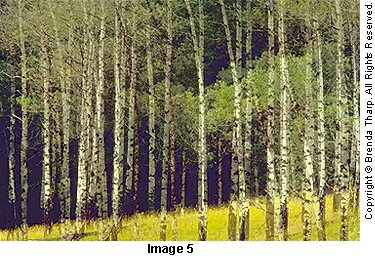
A multiple exposure rendered this impressionistic interpretation of a stand of aspen trees.
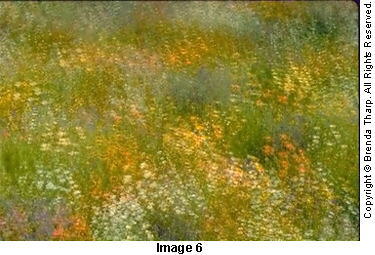
Sixteen exposures on one frame were used to create this pointillistic effect of a wildflower meadow.
c) You can take multiples to the extreme, creating multiple exposures of any number, up to about thirty-two, to render a pointillistic effect like that of Renoir or Monet. For my multiple of a field of flowers (Image #6), I used sixteen exposures on one frame.
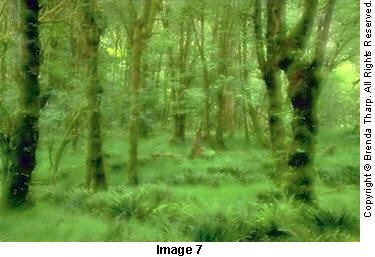
A multiple exposure, one in sharp focus, one out of focus, combined to create this dream-like effect.
6. Create a dream image.
We all have dream images we want to make–the perfect image of a polar bear, a mountain, a flower, etc. What I mean by “dream images” is something that looks like you’re dreaming when you view it. Take the forest scene (Image #7), for example. The lush “greenness” of it made me think that any moment a wood nymph or fairy would flit through the scene. It was an enchanted forest to me. To express that, I created a double exposure, one exposure in focus and one way out of focus. I used a tripod to enable me to see the effect of the out of focus image against the sharp one. I focused in and out over the scene to get a sense of what would happen. The end result is a dream-like expression of the forest.
7. Create a pastel effect.
An overexposed image is often regarded as a “throw-out.” Camera club judges will often reject the image, but when it’s appropriate, an overexposed image can render a pastel, impressionistic effect. Give in to your artistic cravings, and experiment with deliberate overexposure when the scene is delicate, ethereal. Perhaps such photographs should be entered in the pictorial category rather than in the nature or photojournalism venues, where judges expect sharpness.
8. Enhance the grain.
Most of the time photographers strive to remove the grain/noise from their images. Go ahead – use the grain as an artistic tool. Push your ISO up until you get the desired amount of grain or just add noise to your image in post-processing.
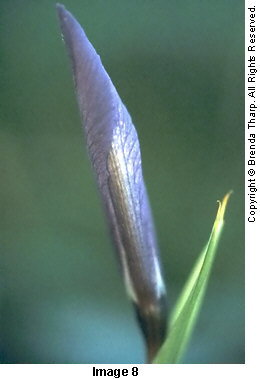
High grain can produce textural effect on your subjects.
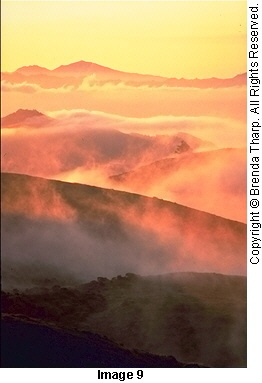
Light, pure, warm and luminescent, is the strength of this image of fog-shrouded rolling hills.
9. Seek out the light.
Even if none of the above techniques speak to you, remember that light is always, first and last, the element that will render a scene beautiful or moody or whatever. (See Image #9) Learn to read the expression of light, and use it to create your own expressive photographs.
In the words of Ralph Waldo Emerson: “Light is the first of painters. There is no object so foul that intense light will not make it beautiful.”
These are just some of the many techniques for creating expressive images, whether it be during spring or any other season of the year. Take on a new perspective and try some of them out. It’s easy for us to forget to play when we’re intent on getting the straight image right. Make that straight image, if you must, and then set yourself free to experiment with the ideas I’ve presented. Above all, have fun. The results will, no doubt, surprise and please you.
by Brenda Tharp
Article and images: © Brenda Tharp. All right reserved.

Leave a Reply